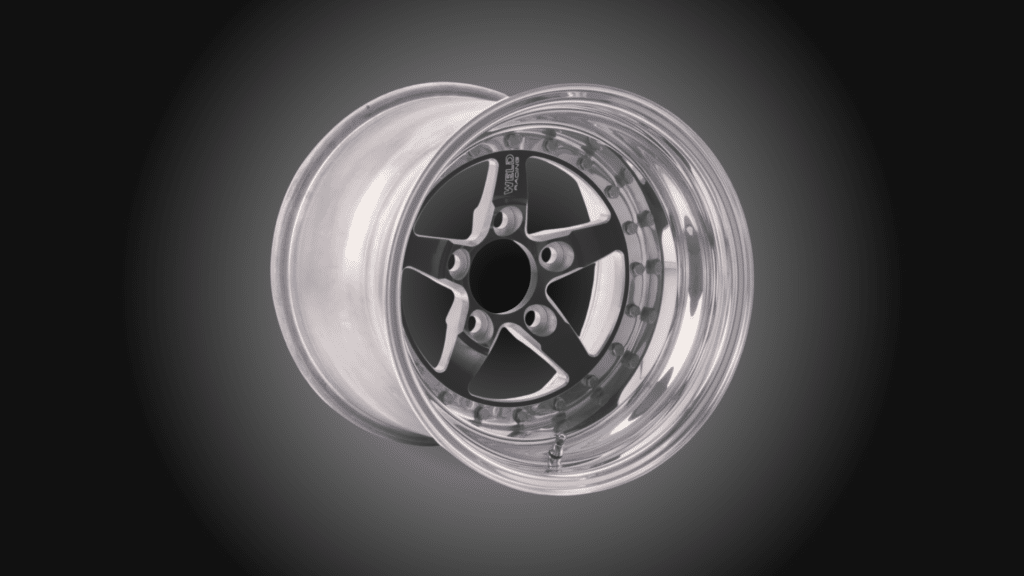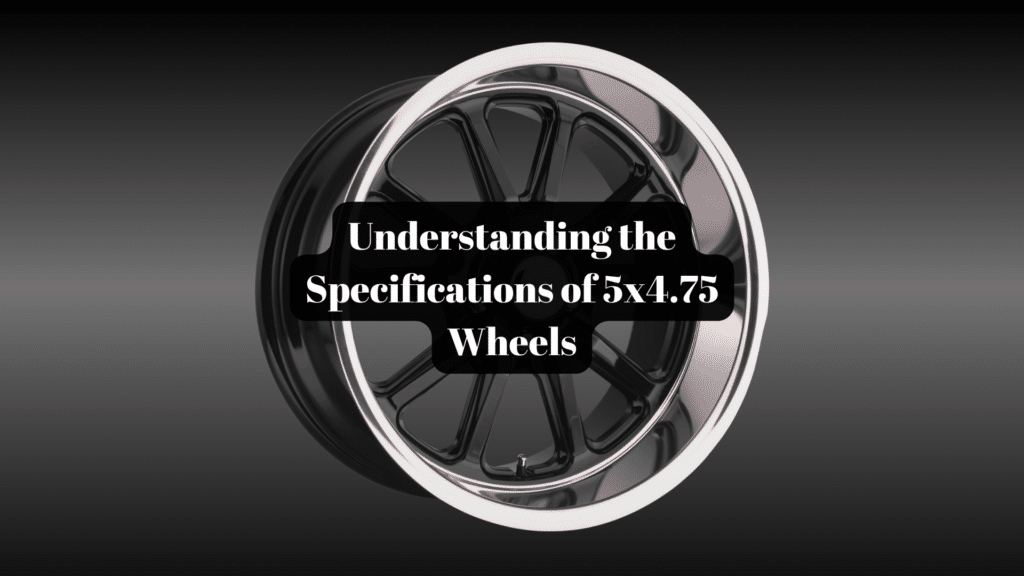When you’re looking for new wheels for your vehicle, numbers like 5×4.75 might seem confusing at first.
These numbers actually represent the bolt pattern of your wheels – specifically, five lug nuts arranged in a circle with a diameter of 4.75 inches.
This measurement is crucial because wheels with the wrong bolt pattern simply won’t fit your car.
In this article, you’ll learn exactly what 5×4.75 means, which vehicles use this pattern, and how to measure it correctly.
I’ll walk you through everything you need to know to find the right wheels for your car.
Many drivers make costly mistakes when buying wheels.
I’ll help you avoid these errors with clear, practical information based on years of automotive experience.
Features to Look for In 5×4.75 Wheels

Bolt pattern and fitment details are the first things I check when looking at wheels.
The 5×4.75 pattern (also called 5×120.65mm) means there are five lug nuts in a circle with a 4.75-inch diameter.
You need to make sure this matches your vehicle exactly. Even small differences can make wheels unsafe to use.
What about materials? You have two main choices:
- Steel wheels cost less and can take more abuse. They’re heavier but won’t crack if you hit a pothole.
- Alloy wheels look better and weigh less. This can improve your car’s handling and fuel use. They also help your brakes cool faster.
Size variations matter, too. The same bolt pattern comes in different widths and diameters.
I’ve seen 5×4.75 wheels ranging from 15 to 20 inches in diameter. Your tire size, vehicle clearance, and driving needs all affect which size works best for you.
Don’t forget about load capacity.
Each wheel has a weight rating that must handle your vehicle’s demands. Hauling or towing? You’ll need wheels with higher ratings.
A quick tip: Check your vehicle’s manual or door jamb sticker for recommended specs. This saves headaches later.
The right 5×4.75 wheels will fit perfectly, support your vehicle’s weight, and match your driving style. Take your time choosing – it’s worth the effort.
Popular Vehicle Models That Use 5×4.75 Wheels
I’ve worked with many vehicles that use the 5×4.75 (or 5×120.65mm) bolt pattern.
You’ll find this specific wheel setup on both old and new models from certain American car makers.
Chevrolet vehicles
These are the most common users of this bolt pattern:
- Camaro (1982-2002)
- Corvette (1963-2004)
- Caprice (1971-1996)
- Impala SS (1994-1996)
- S10 Blazer (1983-2005)
Pontiac models
These models also frequently use this pattern:
- Firebird (1982-2002)
- GTO (2004-2006)
- Trans Am (1982-2002)
Buick
It has several vehicles with this fitment:
- Roadmaster (1991-1996)
- Century (some years)
- Regal (select models)
Did you know? Some Cadillac models like the Fleetwood and older DeVille models also used this pattern.
Many classic muscle cars from the 1960s-1990s came with this bolt pattern. If you own a vintage GM performance car, there’s a good chance it uses 5×4.75 wheels.
Always double-check your specific model year. Even within the same model line, bolt patterns sometimes changed over the years.
Benefits of Upgrading to 5×4.75 Wheels
I’ve seen many cars completely change with the right set of wheels. When you upgrade your 5×4.75 wheels, you’ll notice several important benefits.
Better handling comes first.
Newer wheel designs are often lighter than stock wheels. I’ve found that dropping even a few pounds per wheel makes your car feel more responsive.
Your steering becomes quicker, and your brakes work better because there’s less weight to stop.
Want to know something interesting? Your car’s suspension works more effectively with quality wheels.
This means:
- Smoother rides over bumps
- More stable cornering
- Less strain on other parts
The looks are hard to ignore, too. Stock wheels rarely turn heads. With upgraded 5×4.75 wheels, you can choose styles that match your taste.
I’ve watched plain cars become showstoppers with just a wheel change. Your car’s entire appearance shifts with the right wheels.
More options become available when you look beyond stock wheels. The 5×4.75 pattern has been around for decades, so wheel makers offer countless designs.
You can select from:
- Different finishes (chrome, black, machined, painted)
- Various spoke patterns
- Size options not available from the factory
Better wheels often let you fit better tires, too. This means improved grip in all weather conditions.
The combination gives you a safer, better-performing vehicle.
Your upgrade doesn’t need to break the bank. I’ve found quality wheels at various price points, making this change possible for almost any budget.
Comparing 5×4.75 Wheels to Other Bolt Patterns
I find that bolt patterns often confuse people who are new to wheel shopping. Let me show you how 5×4.75 wheels compare to other common patterns in this simple table:
| Bolt Pattern | Common Vehicles | Main Differences | Availability |
|---|---|---|---|
| 5×4.75 (5×120.65mm) | Older Chevrolet, Pontiac, and Buick models | The standard for classic GM vehicles | Moderate selection, mostly aftermarket |
| 5×5 (5x127mm) | Jeep, older GM trucks, some SUVs | Slightly larger circle than 5×4.75, and won’t interchange | Good selection for trucks and SUVs |
| 5×114.3mm | Most Japanese cars, many modern vehicles | Metric pattern, very common today | Huge selection, widely available |
| 5×4.5 (5×114.3mm) | Ford, Dodge, Toyota, Honda | Same as 5×114.3mm but in imperial measurement | Extensive options, most popular pattern |
| 5x112mm | Audi, Mercedes, Volkswagen | European standard pattern | Good selection, premium options |
The main advantage of sticking with 5×4.75 wheels is perfect fitment for your specific vehicle. You won’t need adapters or modifications.
The downside? I’ve noticed fewer new styles being made in this pattern compared to more modern ones, like 5×114.3mm.
You might see fewer options and sometimes higher prices.
How to Maintain and Care for 5×4.75 Wheels?
Keeping your 5×4.75 wheels in good condition not only makes your vehicle look better but also extends the life of your wheels.
With proper care, these wheels can stay in top shape for years to come.
By following these simple maintenance steps, you’ll keep your 5×4.75 wheels looking great and functioning well for many miles to come.
1. Cleaning Methods
I clean my wheels at least once a month, and you should, too. Start with a hose to remove loose dirt and brake dust.
Use a wheel-specific cleaner that won’t harm the finish. Avoid harsh chemicals, especially on alloy wheels. Soft brushes work best for getting between spokes.
I always clean wheels when they’re cool to the touch – hot wheels can make cleaners dry too quickly and leave spots.
2. Protection Strategies
After cleaning, I apply a wheel sealant or wax. This creates a barrier against brake dust, road grime, and salt.
The protection makes future cleaning easier. For chrome wheels, use chrome-specific products. Alloy wheels benefit from sealants that prevent oxidation.
This simple step adds years to your wheels’ appearance.
3. Checking Lug Nuts
You should check your lug nuts monthly. I use a torque wrench set to manufacturer specifications – usually between 80-100 ft-lbs for most vehicles with 5×4.75 wheels.
Loose lug nuts can cause wheels to wobble and damage the bolt holes. Over-tightening can warp rotors or even break studs.
Have you felt steering wheel vibration lately? That might indicate loose lug nuts.
4. Seasonal Care
Winter brings special challenges. Salt and road chemicals attack wheel finishes. I apply extra sealant before winter starts.
In spring, give the wheels a thorough cleaning to remove built-up salt. Summer heat can lower tire pressure, affecting how wheels perform.
Check pressure more often in hot weather.
5. Storage Tips
If you swap between summer and winter wheels, store the unused set properly. Keep them in a cool, dry place.
I stack mine horizontally or hang them by the hub – never by the tire sidewall.
A wheel bag or cover protects the finish from dust and scratches.
Tips for Choosing the Right 5×4.75 Wheels
Picking the correct wheels for your vehicle involves more than just looking at what catches your eye. So, let’s look at some tips that will help you to choose the right
1. Check Vehicle Compatibility
Always verify your vehicle actually uses the 5×4.75 pattern.
Many similar patterns exist that won’t fit.
Check your owner’s manual or measure the existing wheels carefully.
2. Confirm the Center Bore
The center hole must match your vehicle’s hub diameter.
Too small won’t fit; too large causes centering issues.
Hub-centric rings can help with larger bores.
3. Calculate the Right Offset
Offset affects how wheels sit in wheel wells.
Too much positive offset pushes wheels inward. Too negative makes them stick out.
Measure stock wheels first.
4. Consider Wheel Width
Wider wheels can fit wider tires for better grip.
But too wide may rub against suspension components.
Stay within 0.5 inches of the recommended width.
5. Determine Proper Diameter
Larger-diameter wheels need lower-profile tires to maintain overall diameter.
Keep the total diameter within 3% of the original to avoid speedometer issues.
6. Match Your Driving Style
Highway driving favors lighter wheels. Off-road needs stronger construction.
Track use demands heat-resistant materials.
Choose wheels that suit your driving habits.
7. Balance Appearance with Function
Fancy designs might collect more brake dust and prove harder to clean.
Simple patterns often weigh less and cost less, too.
Conclusion
We’ve covered everything you need to know about 5×4.75 wheels – from the basics of bolt patterns to vehicle compatibility and maintenance tips.
These wheels serve many classic GM vehicles and can truly improve both the look and performance of your car.
Always double-check your measurements before buying new wheels.
The difference between 5×4.75 and similar patterns might seem small, but it’s crucial for proper fitment and safety.
I’ve seen the right wheel choice transform cars, both in looks and handling. You now have the knowledge to make smart decisions about your wheels.
Remember that proper care extends wheel life considerably. Regular cleaning, correct torque, and seasonal maintenance pay off in the long run.
Whether you’re restoring a classic Corvette or updating your Camaro, the right 5×4.75 wheels make all the difference.
Frequently Asked Questions
Can I Use Wheel Adapters to Fit Non-5×4.75 Wheels on My Vehicle?
Yes, adapters can work, but they add stress to wheel studs and may affect handling. Only use high-quality adapters installed by professionals for safety.
How Much Do Quality 5×4.75 Wheels Typically Cost?
Prices range from $100-300 per wheel for basic options, while premium wheels can cost $300-800+ each depending on size, material, and brand.
Will Upgrading to Larger 5×4.75 Wheels Affect My Fuel Economy?
Larger, heavier wheels can slightly reduce fuel economy due to increased rotational mass and potentially wider tires, creating more rolling resistance.


